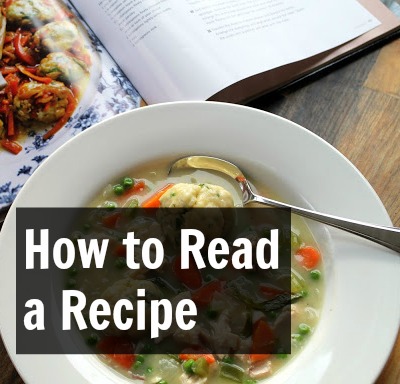So far in this series, we have learned a lot of basics on terms, tools, different knife cuts, simple cooking methods, and even a few simple recipes. At this point it’s fairly easy to branch out and try a few more complicated recipes, however, there’s one last thing to learn before you can really start, which is how to actually read a recipe.
The concept of reading a recipe seems simple, but the fact is that there are a few nuances in a correctly written recipe that will help you understand what the writer is asking you to do. Knowing how to properly read a recipe can improve your cooking by leaps and bounds. So let’s get started.
- Read the whole recipe. That’s right the whole thing, all the way through. That means reading both the ingredients and the instructions. You never know where some hidden ingredient (like water) might be sitting, or the quantity of something in the ingredients list might be split between two different parts, like the egg whites in a meringue and egg yolks in a custard.
- Read it again. Because we both know skimming doesn’t count. Make sure you understand each step that the recipe is asking you to do, and if any of the ingredients need prepping before you begin.
- Gather the equipment and ingredients. Mise en Plas people!
- Understand that recipes are written in an order, usually for a reason. The ingredients are listed in the order that they should be needed and the instructions are listed in an order that will produce the best results. It may be annoying to mix the ingredients for a cake in separate bowls, before combining them, but trust me that’s how you get that velvety texture.
- Always pay attention to the “doneness indicators”. Time and temperature are important when cooking. However, the indicators, such as a golden crispy crust are much more important. If the timer say’s it’s done but the cheese hasn’t begun to melt yet then it needs a few more minutes.
- Note the way that the ingredients are prepared in the list. If it says softened butter, the butter should be taken out an hour before you begin to cook.
- Note the position of the comma. If the comma is after the ingredient measurement and before the cut, chop, dice action, then that means the ingredient is measured before the action. For example, if the ingredients list 1 cup chopped pecans, then the pecans should be chopped prior to measurement, but if the list says 1 cup pecans, chopped then the pecans should be measured whole and then chopped.
That’s the basics for understanding how to read a recipe. Now go on and put it into practice!


I constantly spent my half an hour to read this web site’s content every day along with a cup of coffee.|